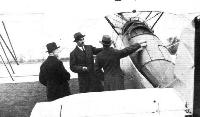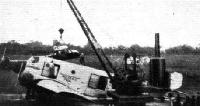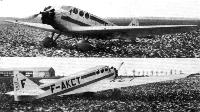Фотографии
-
The photograph shows a line-up at Brooklands of Hawker "Furies" and (behind) "Harts."
Самолёты на фотографии: Hawker Fury - Великобритания - 1931Hawker Hart - Великобритания - 1928
-
G.B.S. FLIES: As reported in "Flight" the other week, Mr. George Bernard Shaw made his first flight on Jan. 23, when he, and Mrs. Shaw, flew over Cape Town in a Junkers machine chartered from S.W. African Airways by Union Airways. Our photograph, which was received last Tuesday per first through Cape-England Air Mail, shows "G.B.S." ready to enter the machine.
Самолёты на фотографии: Junkers F 13 - Германия - 1919
-
An indication of the remarkable progress made in the design and construction of model aeroplanes of to-day may, perhaps, be found in the paper model monoplane, shown in the accompanying illustration, which is presented with every copy of the current issue of the Modern Boy. As will be seen, this model - which follows the lines of the Supermarine Rolls-Royce S.6 Schneider Trophy winner - is faithfully like a full-sized aeroplane, an accomplishment rarely achieved with such models a few years back. Not only is it realistic in appearance, however, but it actually flies, and flies well - as we ourselves demonstrated - and on top of all, in construction it is merely cut out and simply folded together from the printed parts on a sheet (12 x 10 in.) of stiff paper!
Самолёты на фотографии: Supermarine S.5 / S.6 - Великобритания - 1927
-
OVER THE GRAND CANYON: A flight of Curtiss "Condor" Bombers of the U.S. Army Air Corps shown on their way over the Grand Canyon, North Arizona, to the relief of Navajo Indians who were isolated by heavy snowfalls recently.
Самолёты на фотографии: Curtiss Condor 18 - США - 1929
-
Mr. Macpherson is seen explaining the features of the Fairey "Fox" to Col. Tetu and M. Caquot.
Самолёты на фотографии: Fairey Fox - Великобритания - 1925
-
THE BREGUET TYPE 330: Three-quarter front view of the all-metal observation plane (650 h.p. Hispano Suiza), as used by Codos and Robida on their Hanoi-Paris flight.
Самолёты на фотографии: Breguet Br.270 / Br.330 - Франция - 1929
-
The Junkers W.34 "Bolivar" (550 Hornet) at Punta Palmita.
Самолёты на фотографии: Junkers W 33 / W 34 / Ju.46 - Германия - 1926
-
A Morris-Cowley being transported by a Junkers G.31 to the gold fields in New Guinea.
Самолёты на фотографии: Junkers G 31 - Германия - 1926
-
Регистрационный номер: K1991 [2] The Fairey (Napier) Long-Range Monoplane taxying at Cranwell before the Flight to Egypt.
Самолёты на фотографии: Fairey Long-Range Monoplane - Великобритания - 1928
-
Регистрационный номер: K1991 [2] READY FOR THE "LONG HOP": An impression of the Fairey (Napier) long-range monoplane as Dore might have recorded it had he been Flight Staff Photographer, weather conditions are favourable a start for the 6,000-mile non-stop flight to the Cape will be made at dawn to-day.
Самолёты на фотографии: Fairey Long-Range Monoplane - Великобритания - 1928
-
Регистрационный номер: F-ALHG MAROONED IN THE SAHARA: The three French pilots (left to right) Touge, Reginensi and Lenier and their Farman monoplane just before they started out from Le Bourget on a flight to Madagascar. As previously reported they were forced down in the Sahara and were "lost" for several days.
Самолёты на фотографии: Farman F.190 / F.390 - Франция - 1928
-
LESSENING HEAD RESISTANCE. That the new monospar (2 Pobjoys) will be a clean aircraft is here very evident. The cut away wing-root, though by no means a new idea, has not been used of recent years and should, particularly in a twin-engined aircraft of this type, ensure effectiveness of the tail controls at all speeds. Even with the tail on the ground the pilot's view will, in this design, be completely unrestricted.
Самолёты на фотографии: General Aircraft Monospar ST-4 - ST-12 - Великобритания - 1932
-
We show in the accompanying illustration a "working" scale model of a de Havilland "Gipsy Moth" constructed (except for the engine) by Mr. Norman E. Neville, of Fareham. This model, which took just four years to construct, is built to a scale of 1 1/2 in. to the foot, and is correct - to a really remarkable degree - in most of the important details. For instance, the fuselage, wings and tail units are built up with strips of wood strictly according to the original, all the controls work from both cockpits, and the undercarriage, of the latest "Moth" type, is sprung by springs encased and faired in approved style.
Самолёты на фотографии: De Havilland Gipsy Moth / Moth X - Великобритания - 1928
-
THE VICKERS "JOCKEY" INTERCEPTOR FIGHTER: Clean aerodynamic design, high wing loading and low power loading have between then achieved outstanding performance. The maximum speed is nearly 240 m.p.h.!
Two views of the Vickers Type 151 Jockey, a forerunner of the Venom, which was produced four years earlier to Specification F.20/27 for an interception singleseat day fighter. It was powered by a 480 h.p. Bristol Mercury IIA radial engine.Самолёты на фотографии: Vickers Jockey / Type 151 - Великобритания - 1930
-
Modified Dickson Glider built by the Aircraft Club, Harrogate, soaring over the Hole of Horcaun, near Saltersgate.
Самолёты на фотографии: Lippisch / RRG Zogling - Германия - 1926
-
The Cloudcraft "Phantom" soaring above the London Gliding Club site at Dunstable.
Самолёты на фотографии: Cloudcraft Junior / Phantom - Великобритания - 1931
-
VIEW WITHOUT DRAUGHT: The Buhl Aircraft Company of Detroit has recently completed the first Autogiro "pusher," and the machine has been flown by Mr. de la Cierva, who is visiting America at present. The photograph on the left shows Mr. Cierva in conversation with Mr. Harold Pitcairn, President of the Autogiro Company of America. In the right-hand view the machine is seen in flight. It will be noted that the pyramid which carries the rotor head is very tall, so that the occupants can even stand up in the nacelle without being decapitated. The new machine is very reminiscent of the early pusher aeroplanes of Mr. Henry Farman.
Самолёты на фотографии: Buhl A-1 Autogiro - США - 1931
-
THE AKAFLIEG MACHINE: Designed by the Akademische Fliegergruppe, Berlin, this monoplane is slightly more difficult to construct than the Mayer design.
Самолёты на фотографии: Akaflieg Berlin B4 F.F. - Германия - 1931
-
THE MAYER DESIGN: Owing to the low weight of the engine, the nose of the machine is rather disproportionately long.
Самолёты на фотографии: Mayer-Aachen MM1 - Германия - 1931
-
Регистрационный номер: G-ABOH [2] Самолёты на фотографии: RAE Scarab - Великобритания - 1932
-
Регистрационный номер: G-ABOH [2] Самолёты на фотографии: RAE Scarab - Великобритания - 1932
-
NEW FRENCH NIGHT BOMBER: The A.B.20 is a four-engined development of the three-engined commercial typ D.B.70. The engines are Lorraine "Courlis" of 600 h.p. each.
Самолёты на фотографии: Dyle et Bacalan / SAB AB-20 / AB-21 - Франция - 1932
-
Регистрационный номер: F-AKCT [2] Самолёты на фотографии: Wibault Wibault 360 - Франция - 1931
-
Регистрационный номер: F-AKCT [2] THE WIBAULT PENHOET 360 T. 5. MONOPLANE: Three-quarter front and rear views of the new French Tourist or light commercial all-metal machine.
Самолёты на фотографии: Wibault Wibault 360 - Франция - 1931
Статьи
- Flight























